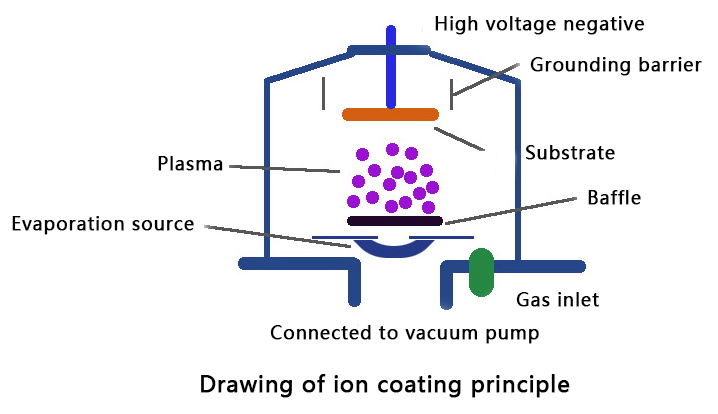The main feature of the vacuum evaporation method for depositing films is the high deposition rate. The main feature of the sputtering method is the wide range of available film materials and the good uniformity of the film layer, but the deposition rate is low. Ion coating is a method that combines these two processes.
Ion coating principle and film formation conditions
The working principle of ion coating is shown in the Pic. The vacuum chamber is pumped to a pressure below 10-4 Pa, and then filled with inert gas (e.g. argon) to a pressure of 0.1~1 Pa. After a negative DC voltage of up to 5 kV is applied to the substrate, a low pressure gas glow discharge plasma zone is established between the substrate and the crucible. The inert gas ions are accelerated by the electric field and bombard the surface of the substrate, thus cleaning the surface of the workpiece. After this cleaning process is completed, the coating process begins with the vaporization of the material to be coated in the crucible. The vaporized vapor particles enter the plasma zone and collide with the dissociated inert positive ions and electrons, and some of the vapor particles are dissociated and bombard the workpiece and the coating surface under the acceleration of the electric field. In the ion plating process, there is not only deposition but also sputtering of positive ions on the substrate, so the thin film can be formed only when the deposition effect is greater than the sputtering effect.

The ion coating process, in which the substrate is always bombarded with high-energy ions, is very clean and has a number of advantages compared to sputtering and evaporation coating.
(1)Strong adhesion, coating layer does not peel off easily.
(a)In the ion coating process, a large number of high-energy particles generated by the glow discharge are used to produce a cathodic sputtering effect on the surface of the substrate, sputtering and cleaning the gas and oil adsorbed on the surface of the substrate to purify the substrate surface until the whole coating process is completed.
(b)At the early stage of coating, sputtering and deposition coexist, which can form a transition layer of components at the interface of the film base or a mixture of the film material and the base material, called “pseudo-diffusion layer”, which can effectively improve the adhesion performance of the film.
(2)Good wrap-around properties. One reason is that the coating material atoms are ionized under high pressure and collide with gas molecules several times during the process of reaching the substrate, so that the coating material ions can be scattered around the substrate. In addition, the ionized coating material atoms are deposited on the surface of the substrate under the action of electric field, so the whole substrate is deposited with a thin film, but evaporation coating cannot achieve this effect.
(3)The high quality of the coating is due to the sputtering of condensates caused by the constant bombardment of the deposited film with positive ions, which improves the density of the coating layer.
(4)A wide selection of coating materials and substrates can be coated on metallic or non-metallic materials.
(5)Compared to chemical vapor deposition (CVD), it has a lower substrate temperature, typically below 500°C, but its adhesion strength is fully comparable to chemical vapor deposition films.
(6)High deposition rate, fast film formation, and could coating thickness of films from tens of nanometers to microns.
The disadvantages of ion coating are: the thickness of the film cannot be precisely controlled; the concentration of defects is high when fine coating is required; and gases will enter the surface during coating, which will change the surface properties. In some cases, cavities and nuclei (less than 1 nm) are also formed.
As for deposition rate, ion coating is comparable to the evaporation method. As for film quality, the films produced by ion coating are close to or better than those prepared by sputtering.
Post time: Nov-08-2022

